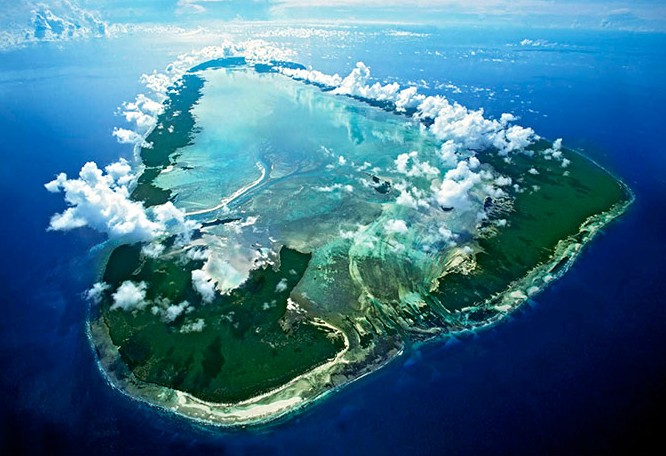A thousand miles off the coast of East Africa in the Western Indian Ocean lies the Republic of Seychelles, a nation of 115 islands with a population of just under 90,000.
The Seychelles is known as a Small Island Developing State (SIDS), but it is more accurately a Large Ocean Developing State (LODS): Like other island countries around the world, the ocean is its peoples’ economy, livelihoods and culture.
 More than half of the GDP of Seychelles depends on fisheries like tuna, and on ocean-based tourism. Because 99 percent of its territory is ocean, its people’s culture and way of life revolves around it. And Seychelles isn’t alone. There are 58 LODS across the globe, and they are home to over 65 million people. Projections show that by 2040, over 80 million people will live in these small island nations—on the front lines of our changing climate.
More than half of the GDP of Seychelles depends on fisheries like tuna, and on ocean-based tourism. Because 99 percent of its territory is ocean, its people’s culture and way of life revolves around it. And Seychelles isn’t alone. There are 58 LODS across the globe, and they are home to over 65 million people. Projections show that by 2040, over 80 million people will live in these small island nations—on the front lines of our changing climate.
In the face of rising tides and increasingly severe storms, coastal communities around the world have to adapt. Fortunately, leaders across many sectors are beginning to recognize potential solutions that already exist—in nature. Not only that, but we’re seeing the adoption of new models for financing these solutions that are potentially replicable around the world.
At The Nature Conservancy, we know that nature protects people. I was shocked the first time I learned that a healthy coral reef can reduce 97 percent of a wave’s energy before it hits the shore, and just 100 meters of mangrove trees can reduce wave height by 66 percent, decreasing the impacts of major storms that are increasingly present due to climate change.
These, and other nature-based solutions are cost-effective, self-maintaining and adaptable to sea-level rise. And they offer other benefits to communities that traditional “grey infrastructure” solutions simply can’t, including improved water quality, fish production and new or improved ecotourism opportunities.
Investment in these valuable natural systems is the key to protecting the people, communities and economy of Seychelles and at-risk coastal communities.
Nature-based Solutions
In the last year we’ve seen the world come together for the UN Climate Conference in Paris, the World Economic Forum in Davos and the U.N. Sustainable Development Goals to call attention to the need for action on climate change. As momentum continues to build, funders in the public and private sectors are coming together to help chart a new course for sustainability and climate adaptations for island nations and coastal communities around the world.
Earlier this year, The Nature Conservancy announced the closing of the first debt-for-nature restructuring with the Government of Seychelles and its Paris Club creditors, designed to help the Government re-direct a portion of its debt payments towards marine conservation and climate adaptation.
The debt restructuring works like this: a third party purchases a country’s debt at a discount, restructures it and then uses the proceeds to fund conservation and activities for ecosystem based adaptation to climate change.
The conversion used a combination of $15.2 million of impact capital and $5 million of grants to buy back a portion of the Seychelles’ debt at a discount – the first time a debt restructuring has used impact capital. The cash flow from the restructured debt is payable to and managed by an independent, nationally based, public-private trust fund called the Seychelles Conservation and Climate Adaptation Trust (SeyCCAT).
Debt service payments fund three distinct streams: one for work on the ground that will help reduce risk through improved management of coasts, coral reefs and mangroves; another to repay impact investors; and a third to capitalize SeyCCAT’s endowment to ensure that these vital adaptation and conservation activities continue for years to come.
The deal will ensure approximately 400,000 square kilometers (98.9 million acres), an area larger than the size of Germany, will be managed for conservation as marine protected areas (MPAs) within five years. The financing will also promote implementation of a Marine Spatial Plan for the entire Seychelles Exclusive Economic Zone, a territory approximately 3,000 times the size of the country’s land mass.
Replicability
LODS like Seychelles are on the frontlines of our changing climate, so they must also be at the front line of the solution. This innovative debt restructuring model, with its combination of public and private funds that leverage each other, creates a new model for public/private co-investment in other areas of the world, notably other LODS.
The model is already attracting interest from other countries and international institutions interested in pursuing similar approaches such as making formal policy and conservation commitments to conclude a debt restructuring and creating Trust entities (like SeyCCAT) to manage the debt restructuring cash flow.
Vulnerable coastal communities and LODS around the world are impacted by the ocean every day. This model can help them use it to their advantage.
“Although we are small, we can make a real difference,” President James Michael of Seychelles said about the debt restructuring. “A difference that brings the best outcomes for Seychelles. And a difference that offers examples in terms of sustainable development, in terms of innovation, and in terms of options for all small island states.”
[seperator style=”style1”]Disclosure[/seperator]
The Nature Conservancy launched its impact capital strategy in 2010 with support from the Robertson Foundation, and has built a global network with support from the Jeremy and Hannelore Grantham Environmental Trust. In early 2014, with founding sponsorship from JPMorgan Chase & Co., NatureVest was launched as a concerted effort to change the way we invest in nature. Visit NatureVest on the Web at www.naturevesttnc.org.











